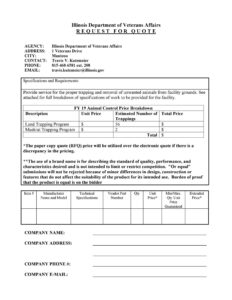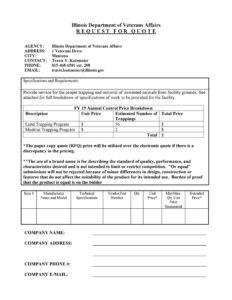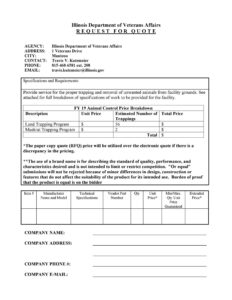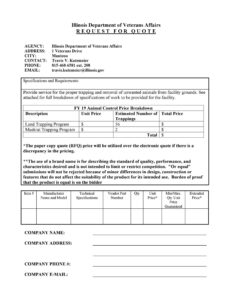Utilizing such a form offers several advantages. It saves time by providing a pre-defined structure, eliminates ambiguity by specifying required information, and promotes transparency by ensuring both parties are working with the same data. This ultimately leads to faster turnaround times, more accurate quotes, and stronger business relationships.
The following sections will explore the key components of effective forms, offer practical examples for various industries, and provide guidance on how to customize them to specific business needs.
Key Components of a Standardized Price Request Form
Effective forms require specific information to ensure clarity and completeness. The following components are essential for a well-structured document:
1: Requestor Information: Complete contact details of the individual or organization requesting the quote, including name, company name, address, phone number, and email address, are necessary for efficient communication.
2: Supplier Information: While often pre-filled, including space for the supplier’s company name, contact person, and contact information helps ensure accurate record-keeping.
3: Date of Request: Clearly dating the request allows for efficient tracking and management of the quotation process.
4: Product/Service Description: Detailed specifications of the required goods or services, including quantities, model numbers, or specific requirements, are crucial for accurate pricing.
5: Delivery/Performance Requirements: Expected delivery timelines, installation requirements, or performance specifications should be clearly stated to avoid discrepancies.
6: Payment Terms: Preferred payment methods and terms should be outlined to ensure alignment between buyer and supplier expectations.
7: Validity Period: Specifying the period for which the quote remains valid helps manage budget expectations and facilitates timely decision-making.
8: Signature Lines: Including space for signatures from both the requestor and supplier formalizes the agreement and reinforces accountability.
Clear communication and comprehensive information exchange are facilitated through these standardized elements. This structured approach ensures that all parties are working with the same data, minimizing misunderstandings and supporting informed procurement decisions.
How to Create a Standardized Price Request Form
Creating a standardized form for requesting pricing ensures clarity and efficiency in procurement processes. The following steps outline the process of developing such a document.
1: Define Required Information: Determine the specific information needed from suppliers. This typically includes pricing, product specifications, delivery timelines, and payment terms. Industry-specific requirements should also be considered.
2: Structure the Form Logically: Organize the form into clear sections with descriptive headings. A logical flow facilitates efficient completion and minimizes the risk of overlooking crucial information. Group related information together, such as requestor details, supplier details, product/service specifications, and payment terms.
3: Use Clear and Concise Language: Employ precise wording to avoid ambiguity and ensure accurate interpretation by suppliers. Avoid jargon and technical terms that may not be universally understood. Provide clear instructions for completing each section of the form.
4: Incorporate Branding Elements: Including company logos and consistent formatting reinforces professionalism and brand identity.
5: Choose an Accessible Format: Select a widely accessible file format, such as a Word document or PDF, to ensure compatibility across different platforms and software versions. This allows recipients to easily access, complete, and return the form.
6: Test and Refine: Before widespread use, pilot test the form with a small group of suppliers to identify any areas for improvement. Gather feedback on clarity, completeness, and ease of use, and revise accordingly.
A well-designed form streamlines communication, reduces errors, and promotes efficient procurement processes. Careful planning and attention to detail ensure a professional and effective tool for soliciting accurate and timely pricing information.
Standardized forms for requesting pricing offer a crucial tool for efficient and transparent procurement. By providing a structured framework for communication between buyers and suppliers, these documents ensure clarity in requests, facilitate accurate pricing, and minimize potential misunderstandings. Key components such as detailed product specifications, clear delivery requirements, and well-defined payment terms contribute to a streamlined process, benefiting both requesting organizations and responding vendors.
Implementing standardized procedures for price requests represents a significant step towards optimized procurement practices. This structured approach fosters stronger vendor relationships, reduces administrative overhead, and contributes to more informed purchasing decisions, ultimately driving cost savings and operational efficiency. Embracing these standardized processes positions organizations for success in today’s dynamic marketplace.



